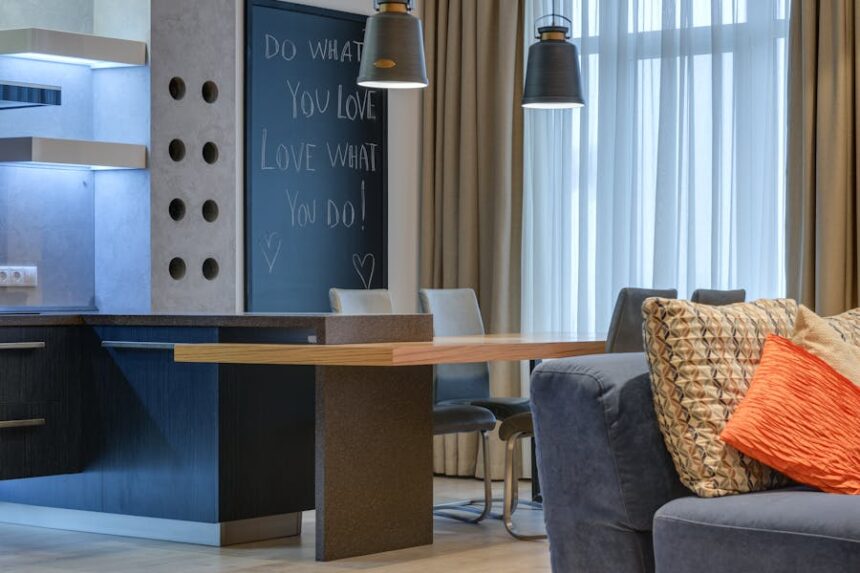There’s something oddly comforting about a table. It’s where we drink coffee, answer emails, sort post, fold laundry, and (occasionally) sit down to eat. But in a world where homes double as offices, gyms and creative studios, the classic table isn’t always enough. Static, single-purpose furniture has begun to feel like a luxury most of us can’t quite justify anymore—especially when square footage is tight.
The modern table is evolving. And it’s doing so with purpose, versatility and a surprising touch of cleverness.
The Rise Of Purposeful Design
It’s no longer acceptable for furniture to just look good. It has to do something—sometimes many things at once. This shift isn’t just about aesthetics, it’s about how we live now. With open-plan layouts, rental constraints and a new wave of remote working, modern homes require pieces that adapt quickly and elegantly to changing demands.
Enter the era of the multi-function table. Coffee tables that rise into desks. Dining tables that fold into console units. Hidden compartments, transformable surfaces, modular parts. These aren’t futuristic oddities—they’re grounded responses to everyday pressures.
And it’s not all about compromise. Thoughtfully engineered designs can actually enhance how we use space. Consider stylish tables with hidden functions: pieces that conceal storage, convert for entertaining, or discreetly tuck away when not needed. They allow rooms to shift between purposes effortlessly—without the clunky visual trade-offs of “space-saving” furniture from years past.
Living Rooms That Work Overtime
Nowhere is multi-functionality more needed than in the living room. Once a sacred space for relaxation, it’s increasingly called upon for Zoom meetings, workouts, craft projects and makeshift guest beds. That coffee table better bring more to the party than just a pretty surface.
Lift-top coffee tables are quietly becoming a staple for anyone working from a sofa. With a quick movement, your tea table becomes a laptop perch at the right ergonomic height. Side tables with nested stools or extendable leaves are another unsung hero—they allow for quick reconfigurations when company arrives or projects sprawl.
The trick is balance. Multi-function shouldn’t mean multi-messy. The best tables conceal their cleverness. A seamless finish, an intuitive movement, and no screaming hinges or visible mechanisms. Just elegance that earns its keep.
Compact Dining With Big Ambitions
Dining tables, traditionally among the largest furniture items, are especially tricky in smaller homes. Permanent six-seaters are wonderful in theory, but how many of us host dinner parties often enough to justify them?
Expandable dining tables are hardly new, but today’s models are different. They’re sleek, minimal, and designed with both everyday functionality and aesthetics in mind. Some pull out with one hand, others rotate to reveal leaves stored inside. No more hauling heavy panels out of cupboards or sacrificing legroom for bulky frames.
What’s refreshing is how unapologetically modern these designs are. They’re not hiding their multi-purpose identity—they’re owning it. Whether you’re working solo or hosting six, they scale with grace.
Redefining Home Offices
The home office is perhaps the most unpredictable zone of all. It can be a full-blown spare room, a bedroom corner, or just the end of a kitchen table. But regardless of where it lives, it needs a surface—and ideally, one that doesn’t visually shout “I work here” when you’re off the clock.
Multi-function tables with built-in storage or retractable tops are a huge asset here. A small console that opens into a workstation can preserve the flow of a space, while tables with cable management keep the tech tangle out of sight. Some even fold flush to the wall, turning back into art shelves or sideboards when not in use.
The ability to toggle between work and rest within the same space is more than a convenience—it’s become a necessity for mental clarity.
When Smart Design Becomes Good Living
It’s easy to think of multi-function tables as niche items—useful for tiny flats or minimalist obsessives. But the truth is, good design benefits everyone. Even in larger homes, pieces that adapt offer more flexibility and less clutter.
The heart of it is about control. You decide when your home expands and contracts. When your table is a desk, and when it’s a dining surface. When storage is visible, and when it’s hidden. There’s a quiet empowerment in that.
And frankly, it’s satisfying. There’s a joy in flipping open a table and revealing more space than expected. In knowing your home is working with you, not against you.
Final Thoughts: Flexibility Is The New Luxury
Modern life isn’t linear. Our routines blur, our spaces multitask, and our needs shift by the hour. Tables, once predictable and static, are finally catching up to the pace of real life.
Multi-function tables aren’t gimmicks—they’re tools for better living. They let us do more with less, keep things elegant, and stay in control of our environments. If your home is feeling cramped or cluttered, don’t rush to upsize. Maybe your table just needs to work a little harder.




